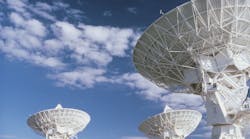Phase noise is a critical parameter in sophisticated radar systems, as well as other types of communication systems. For example, a receiver’s sensitivity can be improved by minimizing phase noise. In the tech brief, “Addressing Phase Noise Challenges in Radar and Communication Systems,” Custom MMIC discusses the importance of phase noise, and breaks down various approaches to overcome the problem.
Initially, the tech brief explains how phase noise is commonly used to define an oscillator’s frequency stability. The phase-noise performance of an oscillator ultimately affects the performance of the system in which it is incorporated. Phase noise can impact the performance of many RF/microwave systems, but the document focuses two in particular: direct-downconversion receivers and radar systems.
Optimizing the phase noise of an oscillator will obviously help to achieve the required system performance. However, the paper points out that an amplifier is often used to increase an oscillator’s output power level in order to sufficiently drive a mixer’s local-oscillator (LO) port. Unfortunately, the amplifier increases the phase noise of the LO signal—all devices add noise power to an input spectrum due to 1/f noise, or pink noise. No doubt, then, that the presence of this amplifier could lead to problems.
A phase-noise plot of a low-noise amplifier (LNA) is provided in the paper. If this noise level is greater than the phase noise of the input signal, the amplifier noise would actually have a greater effect on the output noise spectrum. Therefore, the benefit of using an oscillator with low phase noise is essentially negated due to the phase noise generated by the amplifier.
Amplifier phase noise can be overcome by looking into the device’s physics. Specifically, the document explains why gallium-arsenide (GaAs) bipolar devices are beneficial in terms of phase-noise performance. It goes on to mention several of Custom MMIC’s low-phase-noise amplifiers based on GaAs heterojunction-bipolar-transistor (HBT) technology. The tech brief concludes by discussing how frequency multipliers also can impact phase-noise performance.
Custom MMIC, 300 Apollo Dr., Chelmsford, MA 01824; (978) 467-4290; www.custommmic.com.


